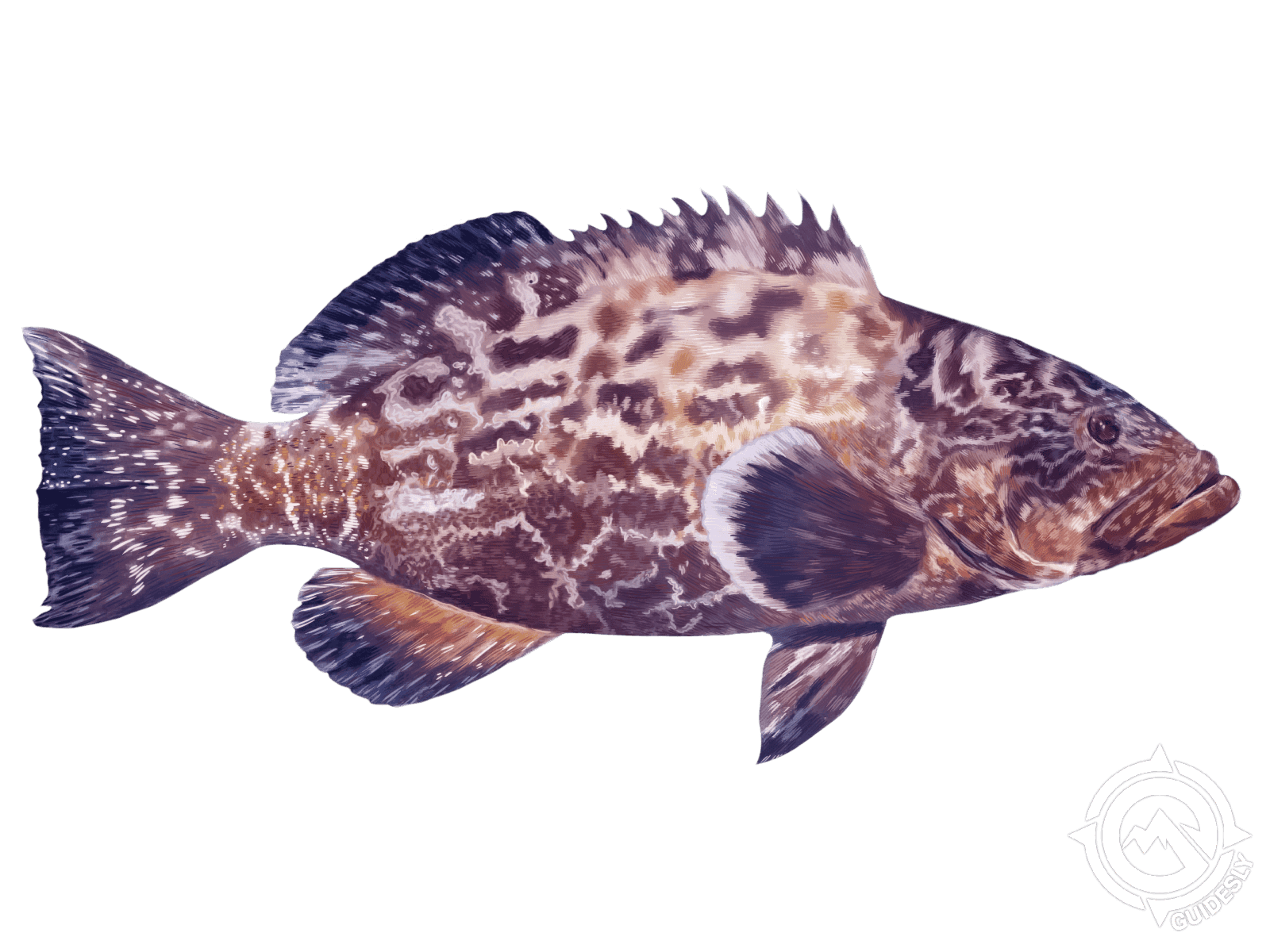Black Grouper

Species Details
Mycteroperca Bonaci
Serranidae
Perciformes
Onshore, Nearshore, Offshore, Reef, Wreck
5 - 20 lbs.
39" - 52"
Black Grouper (Mycteroperca bonaci) Fish Description
The Black Grouper (Mycteroperca bonaci), or sometimes called black rockfish or marbled rockfish, is a saltwater fish usually found in the western Atlantic. Most of the fish’s body is olive or gray except for the dark rectangular blotches (with some brassy spots) scattered all over its body, including the head and fins. Its fins are mostly round except for the square-ish tail and the front part of its two-segment dorsal is spiny. All of the fins are also bordered with rounded dark blue or black colors.
The body of the black grouper is quite meaty and oblong. It has small eyes despite its rather big head and the lower jaw is sticking out. Another distinguishing feature this fish has is the rather roundish preopercle or cheek.
Like most grouper fish species, Black Groupers are protogynous hermaphrodites. This means that all of them are born females. When they reach a certain age and size, or when they reach sexual maturity, many become males for them to be able to reproduce. The spawning season usually starts in November and ends in May. Spawning starts with both the males and females releasing their sperms and eggs in the water. The fertilized eggs would just drift with the current until they hatch. The youngs would then feed mostly on small crustaceans they would find drifting in the water. As they mature to adulthood, they would include small reef fishes like snappers and herrings as well as small squids in their diet.
Interesting Facts About Black Groupers
- The biggest Black Grouper ever caught on record measures five feet long and weighs almost one hundred and twenty five pounds.
- The gigantic Black Grouper was caught by Floridian angler Alex Newman in the Gulf of Mexico during a fishing tournament in 2015.
- Black Groupers are mostly solitary except during spawning season, which usually starts when the weather gets cold.
- They are ambush predators, using their large powerful jaws to snatch unsuspecting prey in reefs.
- Despite being predators, they don’t use their teeth to tear their prey’s flesh.
- They just use their large mouths and gills to suck in their prey.
- They can usually be found in other fish species’ spawning grounds as they prey on aggregating spawning fishes.
- They can live for more than thirty years, with some even reaching fifty years according to some reports.
- The Black Grouper is a favorite target among commercial and sports fishers.
- Its meat is quite tasty and is usually sold whole, filleted, or as steak.
- Its meat has a mild flavor with a soft yet firm texture.
- It said that its meat is rich in vitamins and minerals, including vitamin B6, vitamin B12, phosphorus, potassium, and selenium.
Black Grouper Size and Swimming Speed
Although Black Groupers can reach five feet long and can weigh almost 125 pounds, these sizes are quite rare. Most only average more than 2 feet in length. Because of their girth, Black Groupers are also not built for speed.
Black Grouper Habitat and Distribution
Black Groupers are endemic in the western Atlantic. This means that they can mostly be found off the coasts of Massachusetts extending as far south as southern Brazil. You can also fish for this species within the Gulf of Mexico—where the biggest one is caught—as well as in the Keys and the Caribbean Sea.
Black Groupers tend to stay in coastal waters around offshore wrecks, ledges, reefs, and other structures where they usually hunt for food near the bottom. They are also not that fussy when it comes to the depth they tend to swim in. One can find them in shallow waters of up to thirty feet when the weather is cold. They would however swim in depths of up to three hundred feet during summer and spring.
Black Grouper Fishing Tips
What they lack in speed, the Black Grouper can certainly make up for with their strength and tenacity. So once you hook one, get ready for a long and exhausting battle with this fish. That’s why you should come prepared with heavy duty gear that could withstand the tough fight you’re going to be in. A reel capable of putting out 20-plus pounds of drag at minimum, coupled with an 80lb braided line and a 100lb leader will be enough.
For bait, the Black Grouper is not that picky as they eat anything—may your choice of bait be alive or dead. Just as long as you present your bait where the fish is usually at—which is right at the bottom, it would certainly lunge at anything you might offer it. Also, Black Groupers are not known to nibble at their prey. They tend to suck their food whole. So once you feel a slight tug on your line, start cranking your line in immediately as not to allow the fish to swim back down to the rocks below and snap your line.
Lastly, Black Groupers are usually preyed upon by other reef predators, including sharks and moray eels. So if you’re trying to reel in one, you might also encounter some other aggressive predators that would try to snatch away your prized catch. So be ready to fight with them as well.







